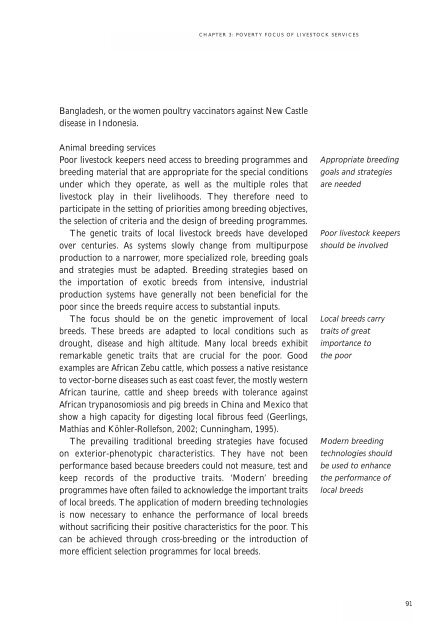Livestock Services and the Poor: A global initiative - IFAD
Livestock Services and the Poor: A global initiative - IFAD
Livestock Services and the Poor: A global initiative - IFAD
You also want an ePaper? Increase the reach of your titles
YUMPU automatically turns print PDFs into web optimized ePapers that Google loves.
CHAPTER 3: POVERTY FOCUS OF LIVESTOCK SERVICES<br />
Bangladesh, or <strong>the</strong> women poultry vaccinators against New Castle<br />
disease in Indonesia.<br />
Animal breeding services<br />
<strong>Poor</strong> livestock keepers need access to breeding programmes <strong>and</strong><br />
breeding material that are appropriate for <strong>the</strong> special conditions<br />
under which <strong>the</strong>y operate, as well as <strong>the</strong> multiple roles that<br />
livestock play in <strong>the</strong>ir livelihoods. They <strong>the</strong>refore need to<br />
participate in <strong>the</strong> setting of priorities among breeding objectives,<br />
<strong>the</strong> selection of criteria <strong>and</strong> <strong>the</strong> design of breeding programmes.<br />
The genetic traits of local livestock breeds have developed<br />
over centuries. As systems slowly change from multipurpose<br />
production to a narrower, more specialized role, breeding goals<br />
<strong>and</strong> strategies must be adapted. Breeding strategies based on<br />
<strong>the</strong> importation of exotic breeds from intensive, industrial<br />
production systems have generally not been beneficial for <strong>the</strong><br />
poor since <strong>the</strong> breeds require access to substantial inputs.<br />
The focus should be on <strong>the</strong> genetic improvement of local<br />
breeds. These breeds are adapted to local conditions such as<br />
drought, disease <strong>and</strong> high altitude. Many local breeds exhibit<br />
remarkable genetic traits that are crucial for <strong>the</strong> poor. Good<br />
examples are African Zebu cattle, which possess a native resistance<br />
to vector-borne diseases such as east coast fever, <strong>the</strong> mostly western<br />
African taurine, cattle <strong>and</strong> sheep breeds with tolerance against<br />
African trypanosomiosis <strong>and</strong> pig breeds in China <strong>and</strong> Mexico that<br />
show a high capacity for digesting local fibrous feed (Geerlings,<br />
Mathias <strong>and</strong> Köhler-Rollefson, 2002; Cunningham, 1995).<br />
The prevailing traditional breeding strategies have focused<br />
on exterior-phenotypic characteristics. They have not been<br />
performance based because breeders could not measure, test <strong>and</strong><br />
keep records of <strong>the</strong> productive traits. ‘Modern’ breeding<br />
programmes have often failed to acknowledge <strong>the</strong> important traits<br />
of local breeds. The application of modern breeding technologies<br />
is now necessary to enhance <strong>the</strong> performance of local breeds<br />
without sacrificing <strong>the</strong>ir positive characteristics for <strong>the</strong> poor. This<br />
can be achieved through cross-breeding or <strong>the</strong> introduction of<br />
more efficient selection programmes for local breeds.<br />
Appropriate breeding<br />
goals <strong>and</strong> strategies<br />
are needed<br />
<strong>Poor</strong> livestock keepers<br />
should be involved<br />
Local breeds carry<br />
traits of great<br />
importance to<br />
<strong>the</strong> poor<br />
Modern breeding<br />
technologies should<br />
be used to enhance<br />
<strong>the</strong> performance of<br />
local breeds<br />
91

















